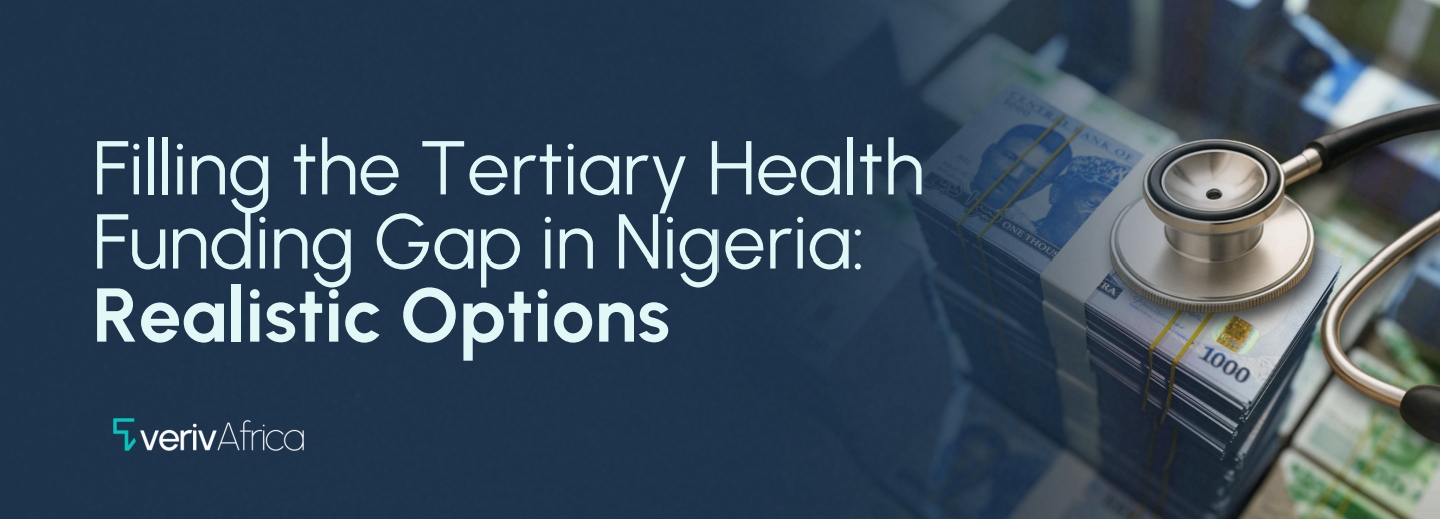In hospitals across Nigeria, patients and staff face a harsh reality: understaffed wards, crumbling buildings, sky-high treatment costs, and the frequent absence of life-saving medical supplies. Every day, challenges such as staff shortages, decaying infrastructure, unaffordable fees, and disappearing supplies turn what should be statistics into life-or-death struggles for millions of citizens. Within the tertiary subsection of the sector, there are key challenges, including the lack of critical equipment, the continued emigration of specialists, and the high cost of procedures. This state of affairs has repeatedly left patients and their families with the unpalatable choice of undergoing expensive life-saving procedures (often outside Nigeria), at the risk of family bankruptcy, or preserving family finances, at the risk of the patient’s life.
In recent years, several policies have been implemented to address the challenges above. The latest is the presidential directive to reduce the cost of dialysis in public hospitals from ₦50,000 to ₦12,000. While well-intentioned, its impact is debatable considering the scarcity of dialysis offerings in many public healthcare facilities, especially in rural areas, and the cost of complementary medications that are not covered by the directive. Like other emergency pronouncements and attempts to reform the healthcare sector through executive orders, the long-term impact of the above policy, in the absence of a follow-on comprehensive policy aimed at addressing the tertiary healthcare challenge in Nigeria, is likely to be muted.
The Tertiary Healthcare Subsector and Its Challenges
The Nigerian tertiary healthcare subsector, like many parts of the Nigerian economy, comprises public and private actors. Public sector players include federal university teaching hospitals, federal medical centres, state university teaching hospitals, and other federal/state reference hospitals. Tertiary hospitals for the military and other uniformed services could also be added to this list.
The number of the above continues to change as new facilities are built, and existing general hospitals are converted into specialist or reference hospitals for both practical and political reasons. Some of the leading players in this category include popular teaching hospitals such as the University College Hospital in Ibadan, the Lagos University Teaching Hospital, and the National Hospital in Abuja, among others.
In the private sector, several tertiary healthcare providers have emerged to fill perceived gaps in the subsector. These players provide a diverse range of offerings, built on differing financial strength and profit motives. Some are privately funded by the founding doctor(s), others are funded by reputable investment consortia, while others are founded and funded by nonprofit bodies, including religious organisations and philanthropic groups. Private sector players, especially for-profit facilities, have designed their offerings for a population that can afford their services and are often located in key commercial centres, such as Lagos, Abuja, and Port Harcourt.
Finally, there is the foreign medical tourism market. While not technically located in Nigeria, the significant amount spent by Nigerians, between $1 and $2 billion recently, and much higher previously, makes it a key part of any discourse on Nigeria’s healthcare system. Key destinations, such as the US, UK, and India, continue to provide medical services to Nigeria, ranging from routine to more complex procedures. A combination of stringent visa policies and a devalued currency has helped stem the tide compared to the numbers reported under previous administrations. However, at $1 billion annually, it remains a key part of the Nigerian health sector.
For the majority of the population, public tertiary hospitals, including federal and state facilities, remain the primary destination for complex medical procedures. While the number and reach of these facilities have increased, as evidenced by a longstanding policy of establishing one federal medical centre in each state that does not have a teaching hospital, the supporting budget, manpower, and facilities have failed to keep up. The continued emigration of doctors, including specialists and consultants, remains a key challenge for the healthcare system. In the past seven years, nearly 16,000 doctors have left Nigeria. This large-scale emigration leaves the doctor-to-patient ratio at just under 4 per 10,000 people, a figure that is nearly half of South Africa’s. Beyond the numbers, this continued emigration, especially of specialists, means a reduced number, or absence of, specialists to conduct complex procedures, especially as the prevalence rates of key diseases, including cancer and heart diseases, increase in Nigeria.
Beyond the manpower challenge, the growth in the number of facilities has not been matched by a corresponding increase in the number of advanced equipment in these facilities. A recent report by the Punch showed that out of the eight federal and state-owned tertiary hospitals in the southwest region of Nigeria, only one has a functional magnetic resonance imaging (MRI) machine: the Lagos University Teaching Hospital. The same could be said for nearly all geopolitical regions and states in the country. The growing number of facilities being constructed or upgraded often lacks the requisite equipment to provide the services expected. Those facilities that had these machines at their inception have seen them break down due to the high cost of repairs and maintenance in the face of limited funding.
Finally, there is the scourge of out-of-pocket payments. Nigeria’s out-of-pocket payment as a percentage of current health expenditures is estimated to be over 76%, one of the highest rates in Africa. The figure is hardly surprising, considering the low levels of insurance penetration in Nigeria, with less than 10% of Nigerians covered by any form of health insurance. Unfortunately, even those covered by these insurance policies face exemptions and caps on the type and frequency of procedures their policies cover, thereby forcing them to resort to out-of-pocket payments for major medical procedures. The combined impact of the above factors means that, in the event of a major health condition requiring an advanced procedure, the average patient is often forced to choose between a relatively affordable but poorly equipped public facility, and a more expensive but well-equipped private or foreign facility. In addition to the aforementioned choice, there is the choice (or lack thereof) between spending huge sums on a medical procedure, at the risk of long-term financial stress or complete bankruptcy to the patient and his/her family, or risking death by avoiding these expensive out-of-pocket payments to preserve family finances.
What Realistic Options Exist?
Public healthcare expenditure, while undeniably important, competes with other needs, including security, education, and infrastructure, among others. Many advocates have called for increased budgetary allocation to the sector. It is a laudable call. However, it is also worth considering what existing decisions could be made differently. For instance, in many states, the aforementioned federal medical centres operate concurrently with other tertiary facilities such as state-owned teaching hospitals and state-owned specialist and reference hospitals. Most, if not all, of these facilities are under-equipped and understaffed, making them only slightly better equipped than general hospitals.
An alternative to this duplication of underfunded facilities, often created and located for political reasons, might be a jointly owned and jointly funded tertiary health system between the federal and state governments. This could be structured as a duly registered special purpose vehicle (SPV) with precise annual funding requirements, a decision-making system, and limited but well-defined focus areas, depending on the prevailing tertiary conditions in the state. This way, these facilities are put on a more financially sustainable footing, have ample funds to recruit and retain the requisite manpower, and can purchase and maintain their equipment.
A follow-up to the above change would be a well-thought-out policy on funding the tertiary healthcare system in a way that is sustainable and affordable. Will the government increase its allocation to the healthcare system at the expense of other sectors? Will a few of the above SPVs be upgraded to centres of excellence to reverse some of the $1-$2 billion of foreign medical tourism expenditure leaving the country? Or will the leading SPVs focus on attracting medical tourists from other African countries, and using the increased funding gained to subsidise the cost of select tertiary procedures for the Nigerian population? All three of these options can be pursued to help create a self-sustaining and robust tertiary hospital subsector.
Finally, the challenge posed by out-of-pocket payments must be addressed. Realistically, comprehensive universal health coverage is out of reach for many states today without external support. For a state with a population of five million, paying an annual premium of ₦50,000 per resident to provide universal coverage (to the extent that insurance companies are willing to accept this low premium) would cost over ₦250 billion, a figure that is nearly 50-70% of the budget of many Nigerian states. The other option would be to provide all services for free; an option with its own challenges, including service efficiency and long-term financial sustainability. A more cost-efficient alternative is to create a bucket of high-cost procedures (such as cancer treatment and kidney transplant) that could completely wipe out the savings and assets of average residents in the state. These procedures could be funded by a special fund in the budget, thereby providing some level of insurance to residents, preventing the unpalatable choice between death and family solvency, and ensuring that other state needs are met by the government. As the economy grows, more procedures could be added to the bucket until governments feel reasonably confident about a full-blown universal coverage system.
In conclusion, the states and the federal government must design a tertiary healthcare system that ensures facilities are well-equipped, staffed by a motivated workforce, and designed to ensure continued financial sustainability while easing the payment burdens on residents. The practice of politically motivated construction of empty tertiary hospitals and directives that are at odds with the realities on the ground must be replaced by well-thought-out policies aimed at reviving the sector and turning it into a source of inbound revenue generation.
References
Federal Teaching Hospital Gombe (2025). Historical Background. https://fthgombe.gov.ng/historical-background/
Kennedia HMO (2025). Challenges and Opportunities in Nigeria’s Health Insurance Market. https://kennediahmo.com/life-insurance/challenges-and-opportunities-in-nigerias-health-insurance-market-what-you-need-to-know/#:~:text=Low%20Insurance%20Penetration,making%20affordability%20a%20major%20issue.
Nairametrics (2025). Why Nigerians Can no longer go abroad for treatment. https://nairametrics.com/2025/07/19/medical-tourism-why-many-nigerians-can-no-longer-go-abroad-for-treatment-olakunle-onakoya-cedarcrest-ceo/
The Punch (2025). 16,000 Doctors Left Nigeria in seven years. https://punchng.com/16000-doctors-left-nigeria-in-seven-years-minister/
World Bank Group (2025). World Development Indicators. https://data.worldbank.org/indicator/SH.XPD.OOPC.CH.ZS










